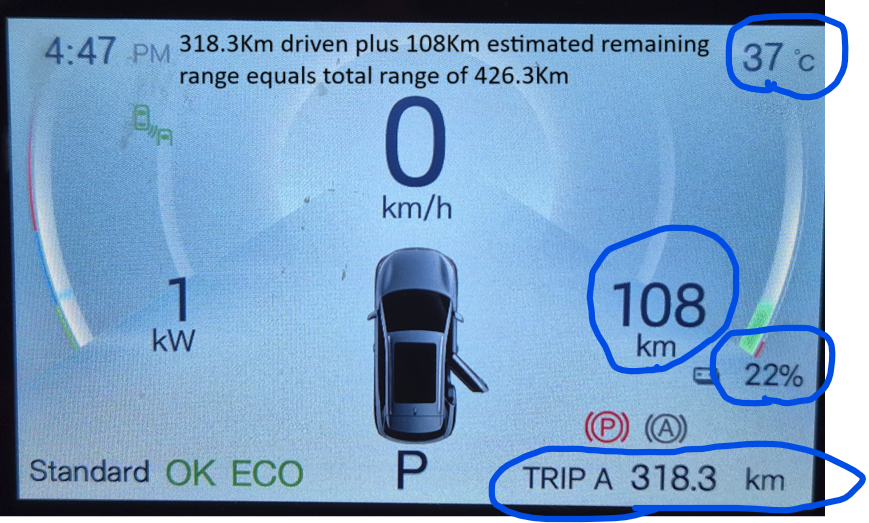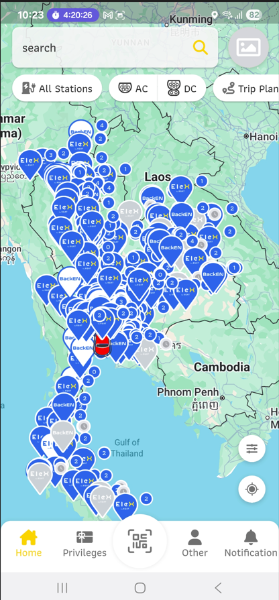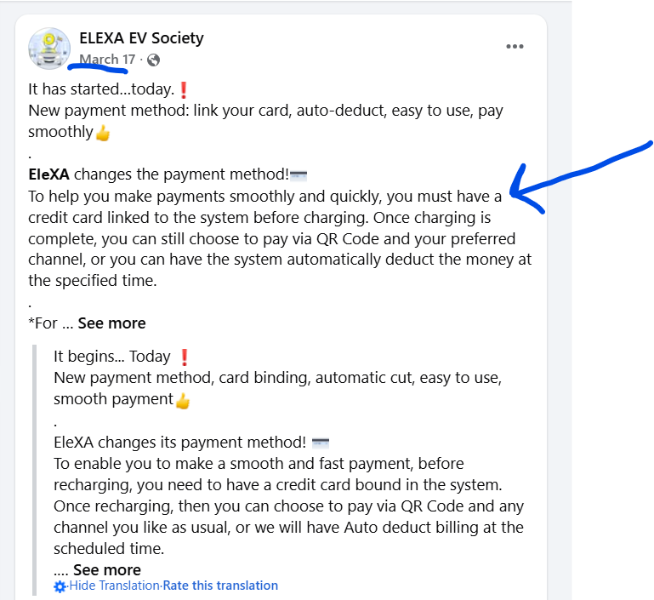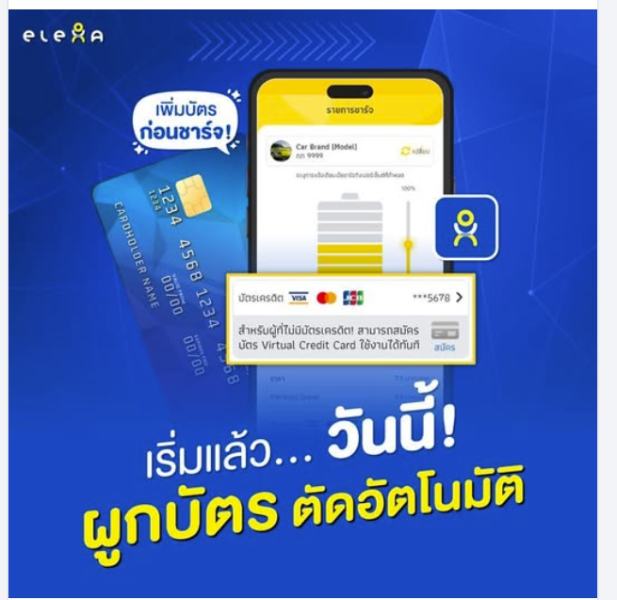-
Posts
29,235 -
Joined
-
Last visited
Pib's Achievements
-
Yeap....filling-up with dino fuel is pretty fast but a lot more expensive than electrons going into a battery for the same amount of kilometers.
-
Below is from the EV Assn of Thailand (EVAT) website showing the number of EV commercial chargers in Thailand as of 30 June 2025. Now, it does not show "all" charging companies/networks in Thailand (more are popping up all the time), but just the networks that want to report charging station stats to EVAT. More charging networks exist in Thailand but the great majority of the commercial charging networks are shown on the chart. Can give a person a good idea which charging networks they might want to register with based on number of charging locations, number of chargers like DC Fast Chargers, etc. https://evat.or.th/ev-information/current-status/index Below is a zoom-in snapshot of the Top 7 networks...maybe the networks most EV owners should consider registering with for long road trip purposes....for those trips that you know you will need to recharge to get back home.
-
And today/10 Aug the wife and I did a over a 300km out & about trip for some Sunday site seeing. It was fairly hot...temp around 35 to 38C during the trip...temp at 37C once arriving back home around 5pm. A/C set to 23C the whole way. Mostly highway speed driving in the 70 to 90KmH ballpark (a few kilometers closer to 100KmH) although we ran into a couple of 15 minute traffic jams where we just crawled along for about 15 minutes. In ECO mode the whole way and I drove conservatively. Left Bangkok with a 100% charge...drove over towards the Myanmar-Thailand border for a round trip of 318.3Km....around a 75Km of this trip was going up and down hills close to the border....some of the hills were pretty steep....beautiful scenery. When we got back home to Bangkok the 2023 Atto Extended range had 22% battery charge remaining with estimated remaining range of 108Km. Per the text I added to the image below that equates to a 426.3Km total range, exceeding the Atto's "WLTP" range spec of 420Km. If I had done the trip in the cooler part of the year like say around Nov to Jan I would have gotten a total range of around 440km based on previous tests I've done.
-
And the reason I've making a real effort to regain Elexa charging capability is because there are many of them around Thailand on main roads. Many PT fuel stations (not to be confused with PTT stations) have an Elexa charging station. I just see a lot of Elexa chargers in my drives here and there. As an example, there is a new PT station (fancy one) still under construction about half way between Bangkok and Nakhon Pathom City on Phet Kasem Road (#4)....it's located at a junction where a major new road that connects Phet Kasem to Motorway M81. Now this new PT "station/mall" isn't fully completed but has already partially opened. At this PT location is a row of Elexa 150KW DC fast chargers for "six" vehicles. When the wife and I drove around this PT location today around 3pm that 6 vehicle Elexa location had 4 of 6 parking slots filled....EVs charging. Snapshot from Elexa app...Elexa charger locations around Thailand
-
Here's a post from the Facebook Elexa EV Society page announcing the payment policy change effective 17 March. "Must have a "credit" card loaded in your Elexa payment profile before you can even begin charging. If you do have an acceptable card load then you can start a charging session and then at the end pay via that credit card "or" QR code/PromptPay. And I just love how the post says this policy change is to make payments smoothly and quickly. LOL. In some way it benefits/protects Elexa vs making it easier for the customer. https://www.facebook.com/ElexaEVSociety/ Translation of below image basically says effective 17 March a "credit" card is required to charge using Elexa.
-
Well, I think I just may have overcome the problem of not have a "credit card that Elexa will accept." As talked in my above 9 May post in mid March Elexa made a payment policy change in types of cards accepted for payment such as no longer accepting "Thai debit cards" or "foreign credit/debit cards." They now only accept "Thai credit cards" n your Elexa card payment profile based on discussions with Elexa Customer Service, Facebook posts, etc. While you may have successfully used a Thai or foreign debit card earlier and it was loaded in your Elexa profile, after around mid March that would no longer work. In fact, now a person can not even start a charging session unless an acceptable "credit" card is loaded in your Elexa app payment profile....and remember just because you had a foreigner credit card loaded before mid March that does not mean it will still work with Elexa after mid March as Elexa now only accepts "Thai credit cards." About a week ago I tried re-adding my Bangkok Bank debit card to my Elexa profile just to see if "maybe" Elexa might accept it now as many people have complained to Elexa about their March policy change, but the card still wasn't accepted. I sent another polite "gripe" to Elexa via their LINE customer surface account as they are pretty good in responding fast Mon-Friday and with good English. Elexa did respond quickly again but once again confirmed Bangkok Bank debit cards are not accepted although they phased it as Elexa is "having an issue with Bangkok Bank debit cards." But on Facebook I don't see anyone with "any debit card" having any luck. This time in the Elexa customer service response they recommended I registered for a TrueMoney acct which comes with a "virtual TrueMoney credit card" as that will be accepted by Elexa. Well, I didn't have a TrueMoney account and had reservations about a farang even being able to register for a TrueMoney account now and then even if I could register would TrueMoney really provide a "virtual credit card" for a farang or would credit cards only be allowed for Thais. Anyway, I went thru the process to registered for a TrueMoney account...only needed a copy of my passport main page and Thai drivers licenses (other docs other than a Thai drivers license also acceptable)....had some issues in getting a successful face scan match with my passport picture but got that resolved after a few days....finally got just the right "lighting" I guess to satisfy (i.e., pass the face scan) using TrueMoney app registration process After getting approved for a TrueMoney acct I added Bt200 to the TrueMoney wallet via mobile bank QR code transfer....and then I activated my TrueMoney virtual credit card and I was also able to activate a TrueMoney SME virtual credit card that provides 3% cash back. Just takes a few seconds to activate the cards. And you can turn the cards on of off for fraudulent transaction protection purposes....just takes a second to turn off or back on. The amount of credit line is totally based on your TrueMoney wallet balance as these cards are basically "prepaid credit cards"....whatever the balance is in your TrueMoney wallet is the card's credit line of the moment. Ex: if you have a Bt500 wallet balance then you have a credit card limit of Bt500, wallet balance of Bt5,000 then a credit card limit of Bt5,000, etc. Got more studying to do to see what the upper limit is as I'm total newbie to TrueMoney. This afternoon I tried adding my TrueMoney virtual credit card to the Elexa app and was successful on first try. I also added the card to two other charging apps....ReverSharger and PTT. The Elexa card add process actually debited a few baht from the card and then immediately refunded that amount. ReverShcarger and PTT didn't debit/credit any amounts....the card was simply accepted. Now I just need to do a complete real world test at a charging station to see I can now "start" and pay for an Elexa charging session....and I'll do the same with ReverSharger and PTT although I have multiple acceptable payment methods already setup with ReverSharger and PTT. It's just Elexa that was giving me grief in being able to setup a payment option. I also think from talking to the Elexa Customer Service and looking at some Facebook posts that at the end of an Elexa charging session (which a person can now only start if having an acceptable credit card in your Elexa profile) that you will be offered the choice of paying via that credit card or QR code/PromptPay.....but no credit card on file prevents a person from ever reaching the final payment stage (or even starting a charging session). Time will tell when I do my Elexa real world test over the next week or so.....it may not be until next weekend when visiting the mother-in-law as there is a Elexa charger close to her home. Yeap, keeping my fingers crossed the TrueMoney virtual Mastercard credit card will fix my Elexa payment issue and also offers me more ways to pay when using other charging apps besides just Elexa. In fact, it could turn out that I start using the TrueMoney virtual credit card in all my charging apps as the default payment method....time and testing will tell....fingers crossed.
-
2025 SSA Form 7162 - "Hello, are you dead yet?" forms.
Pib replied to connda's topic in US & Canada Topics and Events
Yes...Thai Post airmail. No tracking with regular airmail. If you want tracking then you must go registered airmail which costs a lot more....around Bt350. And even then once the registered airmail arrives the US Entry point that's where the tracking/scans may stop. Plus registered airmail will typically take 2 to 3 times longer to arrive due to special (slower) handling for security purposes. And of course you can use EMS which costs well over Bt1000 which will provide tracking and faster delivery but once again tracking "might" not show final delivery.. -
2025 SSA Form 7162 - "Hello, are you dead yet?" forms.
Pib replied to connda's topic in US & Canada Topics and Events
I expect the 31 July date on the form was a "post" date kinda like post dating a check. Just a ref date for SSA use only...and to make the recipients feel like they had received the form quickly and haven't lost too many days on the return within 60 days clock. I expect SSA actually mailed the form in the 20 to 25 July ballpark. -
Military Submarine Replica Goes on Display in Sattahip
Pib replied to Georgealbert's topic in Pattaya News
Yea, the opening post article does say it's a "life size" model, but the article is probably wrong. When googling for Yuan Class S26T submarine the below ThaiRath newspaper has an article and pictures that show it being a much bigger sub almost 80 meters long. https://www.thairath.co.th/news/society/2874862 -
Here's some good general info on EV battery buffers, reserve, etc. https://evkx.net/technology/battery/buffer/
-
2025 SSA Form 7162 - "Hello, are you dead yet?" forms.
Pib replied to connda's topic in US & Canada Topics and Events
And the other member of the husband and wife team received their 7162 today here in Bangkok. -
With my Atto its remaining range it displays all the way down to at least 1% and 5Km...on both the car display and on the app....and the app is just relaying OBD2 data that the EV range display also shows. I expect how well calibrated the car's BMS/range guess-o-meter is may determine how the EV's display remaining range is displayed at a very low battery level. A "few" (not just one) charges well below 10%....like say down to around 5% or a little less should make the EV range display more accurate when dropping below 10% and getting close to 0%....will make the 0 to 10% range more accurate. Since an LFP battery voltage level is very flat between in approx 10% to 95% charged ballpark it's hard for the BMS/range meter to do a good recalibration until the battery is drained to below 10% where the battery's voltage flatness starts to drop significantly which allows the BMS/range circuity to measure a voltage that is significantly lower than the battery's normally "really flat voltage in the 10-95% ballpark....being able to see this significantly lower voltage below 10% a few times permits a better recalibration.
-
I take range specs along with laboratory results (perfect world and with A/C & heating turned off) and real world testing testing (with each world being different) with a HUGE grain of sale. Like the Atto Extended range numbers above....that 480km lab range is China NEDC specs (pie in the sky....like driving downhill with a tail wind all the time specs)....and in countries that require WLTP specs the Atto Extended range specs is 420Km. WLTP specs are much tougher/more in-line with real world results "if a person always drives in ECO mode, drives conservatively, doesn't have hills to climb, and even with A/C running." I have a 2023 Atto Extended range and I "can" get the Atto WLTP range of at least 420km....and during the cooler part of the year I've got up to a 442km real world range driving around here in the greater Bangkok area and surrounding provinces where I rarely exceed 90Km per hour with the A/C on and one passenger (i.e., by wife as the backseat driver). Now during the hottest part of the year where the A/C has to work extra hard under the bright & hot sun and I'm not being very conservative in my driving then yea, the real world range drops to around 380-400Km based on "me" and where "I" drive....practically no hills involved....good main roads in the greater Bangkok area/surrounding provinces/light breezes....a good amount of speeds in the 60-90kmH ballpark....and even a fair amount of stop-and-go horrendous Bangkok traffic jam traffic. For example below is a 2 Sep 2024 (still hot weather) snapshot of my 2023 Atto display where I was doing a range test and intentionally draining the battery down to under 10% in order to do a BYD recommended periodic discharge to 10% or less followed by full charge to 100% to recalibrate the BMS/range guess-o-meter circuits. At 1% charge remaining I was at 419Km with around another 5km of range remaining....when hitting zero I would have had a range of around 425Km which exceeds the Atto's WLTP 420Km rating. And in other range testing during the cooler part of the year I have reached up to 442km real world range. I have got real world range test results in the 420 to 442km ballpark numerous times. with a BIG grain of salt.
-
It can go fast when a person has all their "paperwork ducks" lined-up. But also keep in mind that BOI does an "initial" check for paperwork before accomplishing a more series review and before sending it to Other Govt Agencies for their review/blessing/coordination. The "initial" BOI review is to spot obvious problems, missing documents, etc., before a more thorough evaluation is done by others in BOI and other govt agencies. It's kinda if buying a car where you do a walkaround first, kick the tires, start the car to listen to the engine at idle, etc., "before" you want to consider taking it out for a test drive for a more serious review. Then if it passes the test drive/more serious review you then set down with the sales person to take the final steps of buying the car like signing a few docs, how you will pay, when you will make payment, etc.























